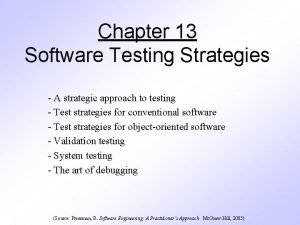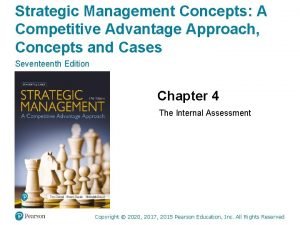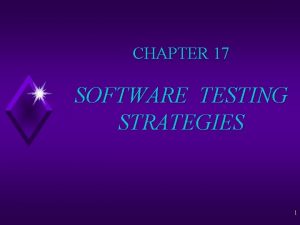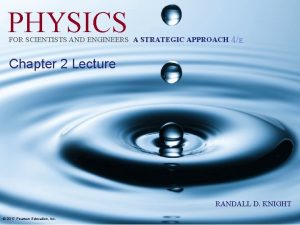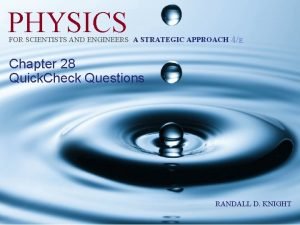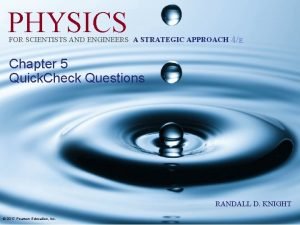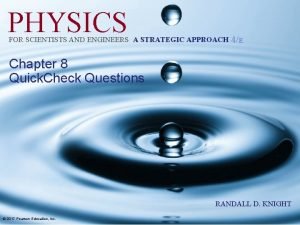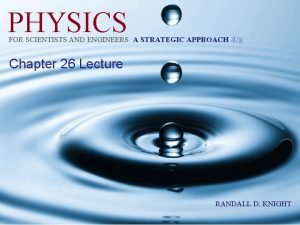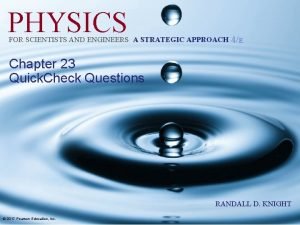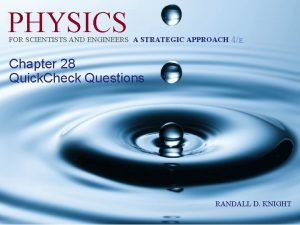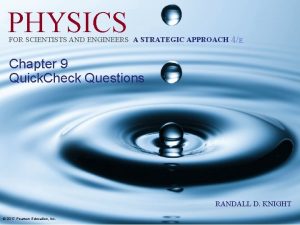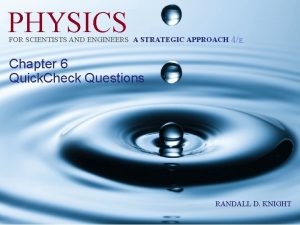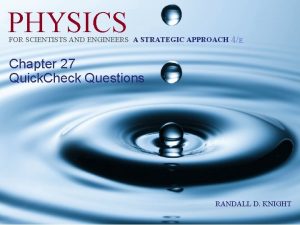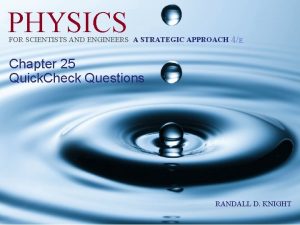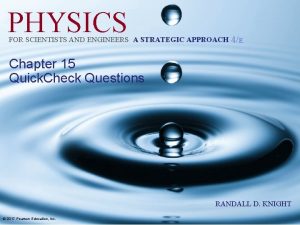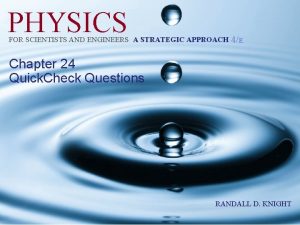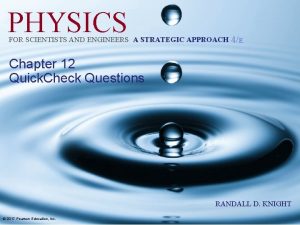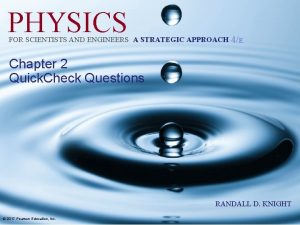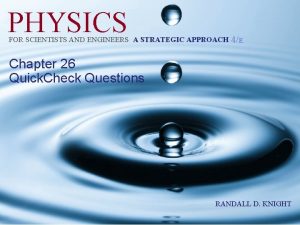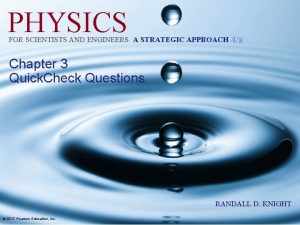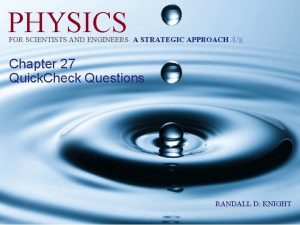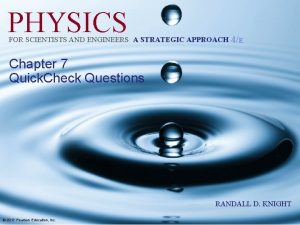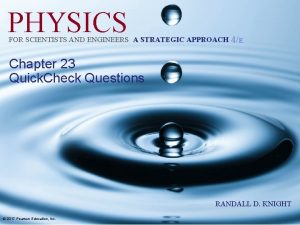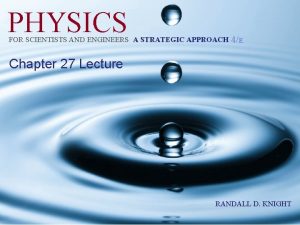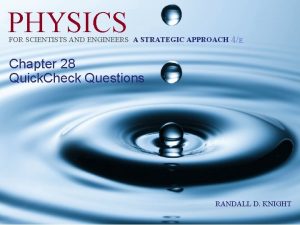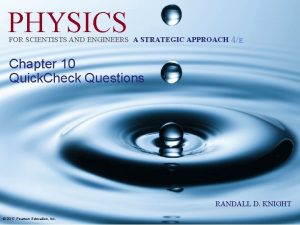PHYSICS FOR SCIENTISTS AND ENGINEERS A STRATEGIC APPROACH



































- Slides: 35

PHYSICS FOR SCIENTISTS AND ENGINEERS A STRATEGIC APPROACH 4/E Chapter 4 Quick. Check Questions RANDALL D. KNIGHT © 2017 Pearson Education, Inc.

Quick. Check 4. 1 A particle undergoes acceleration while moving from point 1 to point 2. Which of the choices shows the velocity vector as the object moves away from point 2? © 2017 Pearson Education, Inc. Slide 4 -2

Quick. Check 4. 1 A particle undergoes acceleration while moving from point 1 to point 2. Which of the choices shows the velocity vector as the object moves away from point 2? © 2017 Pearson Education, Inc. Slide 4 -3

Quick. Check 4. 2 A heavy red ball is released from rest 2. 0 m above a flat, horizontal surface. At exactly the same instant, a yellow ball with the same mass is fired horizontally at 3. 0 m/s. Which ball hits the ground first? A. The red ball hits first. B. The yellow ball hits first. C. They hit at the same time. © 2017 Pearson Education, Inc. Slide 4 -4

Quick. Check 4. 2 A heavy red ball is released from rest 2. 0 m above a flat, horizontal surface. At exactly the same instant, a yellow ball with the same mass is fired horizontally at 3. 0 m/s. Which ball hits the ground first? A. The red ball hits first. B. The yellow ball hits first. C. They hit at the same time. © 2017 Pearson Education, Inc. Slide 4 -5

Quick. Check 4. 3 A 100 g ball rolls off a table and hits 2. 0 m from the base of the table. A 200 g ball rolls off the same table with the same speed. It lands at distance A. B. C. D. E. 1. 0 m. Between 1 m and 2 m. 2. 0 m. Between 2 m and 4 m. 4. 0 m. © 2017 Pearson Education, Inc. Slide 4 -6

Quick. Check 4. 3 A 100 g ball rolls off a table and hits 2. 0 m from the base of the table. A 200 g ball rolls off the same table with the same speed. It lands at distance A. B. C. D. E. 1. 0 m. Between 1 m and 2 m. 2. 0 m. Between 2 m and 4 m. 4. 0 m. © 2017 Pearson Education, Inc. Slide 4 -7

Quick. Check 4. 4 Projectiles 1 and 2 are launched over level ground with the same speed but at different angles. Which hits the ground first? Ignore air resistance. A. Projectile 1 hits first. B. Projectile 2 hits first. C. They hit at the same time. D. There’s not enough information to tell. © 2017 Pearson Education, Inc. Slide 4 -8

Quick. Check 4. 4 Projectiles 1 and 2 are launched over level ground with the same speed but at different angles. Which hits the ground first? Ignore air resistance. A. Projectile 1 hits first. B. Projectile 2 hits first. C. They hit at the same time. D. There’s not enough information to tell. © 2017 Pearson Education, Inc. Slide 4 -9

Quick. Check 4. 5 Projectiles 1 and 2 are launched over level ground with different speeds. Both reach the same height. Which hits the ground first? Ignore air resistance. A. Projectile 1 hits first. B. Projectile 2 hits first. C. They hit at the same time. D. There’s not enough information to tell. © 2017 Pearson Education, Inc. Slide 4 -10

Quick. Check 4. 5 Projectiles 1 and 2 are launched over level ground with different speeds. Both reach the same height. Which hits the ground first? Ignore air resistance. A. Projectile 1 hits first. B. Projectile 2 hits first. C. They hit at the same time. D. There’s not enough information to tell. © 2017 Pearson Education, Inc. Slide 4 -11

Quick. Check 4. 6 A factory conveyor belt rolls at 3 m/s. A mouse sees a piece of cheese directly across the belt and heads straight for the cheese at 4 m/s. What is the mouse’s speed relative to the factory floor? A. B. C. D. E. 1 m/s 2 m/s 3 m/s 4 m/s 5 m/s © 2017 Pearson Education, Inc. Slide 4 -12

Quick. Check 4. 6 A factory conveyor belt rolls at 3 m/s. A mouse sees a piece of cheese directly across the belt and heads straight for the cheese at 4 m/s. What is the mouse’s speed relative to the factory floor? A. B. C. D. E. 1 m/s 2 m/s 3 m/s 4 m/s 5 m/s © 2017 Pearson Education, Inc. Slide 4 -13

Quick. Check 4. 7 This is the angular velocity graph of a wheel. How many revolutions does the wheel make in the first 4 s? A. B. C. D. E. 1 2 4 6 8 © 2017 Pearson Education, Inc. Slide 4 -14

Quick. Check 4. 7 This is the angular velocity graph of a wheel. How many revolutions does the wheel make in the first 4 s? A. B. C. D. E. 1 2 4 6 8 © 2017 Pearson Education, Inc. Δθ = area under the angular velocity curve Slide 4 -15

Quick. Check 4. 8 A ball rolls around a circular track with an angular velocity of What is the period of the motion? A. s B. 1 s C. 2 s D. s E. s © 2017 Pearson Education, Inc. Slide 4 -16

Quick. Check 4. 8 A ball rolls around a circular track with an angular velocity of What is the period of the motion? A. s B. 1 s C. 2 s D. s E. s © 2017 Pearson Education, Inc. Slide 4 -17

Quick. Check 4. 9 A car is traveling around a curve at a steady 45 mph. Is the car accelerating? A. Yes B. No © 2017 Pearson Education, Inc. Slide 4 -18

Quick. Check 4. 9 A car is traveling around a curve at a steady 45 mph. Is the car accelerating? A. Yes B. No © 2017 Pearson Education, Inc. Slide 4 -19

Quick. Check 4. 10 A car is traveling around a curve at a steady 45 mph. Which vector shows the direction of the car’s acceleration? E. The acceleration is zero. © 2017 Pearson Education, Inc. Slide 4 -20

Quick. Check 4. 10 A car is traveling around a curve at a steady 45 mph. Which vector shows the direction of the car’s acceleration? E. The acceleration is zero. © 2017 Pearson Education, Inc. Slide 4 -21

Quick. Check 4. 11 A car is slowing down as it drives over a circular hill. Which of these is the acceleration vector at the highest point? © 2017 Pearson Education, Inc. Slide 4 -22

Quick. Check 4. 11 A car is slowing down as it drives over a circular hill. Which of these is the acceleration vector at the highest point? Acceleration of changing speed Acceleration of changing direction © 2017 Pearson Education, Inc. Slide 4 -23

Quick. Check 4. 12 Rasheed and Sofia are riding a merry-go-round that is spinning steadily. Sofia is twice as far from the axis as is Rasheed. Sofia’s angular velocity is ______ that of Rasheed. A. half B. the same as C. twice D. four times E. We can’t say without knowing their radii. © 2017 Pearson Education, Inc. Slide 4 -24

Quick. Check 4. 12 Rasheed and Sofia are riding a merry-go-round that is spinning steadily. Sofia is twice as far from the axis as is Rasheed. Sofia’s angular velocity is ______ that of Rasheed. A. half B. the same as C. twice D. four times E. We can’t say without knowing their radii. © 2017 Pearson Education, Inc. Slide 4 -25

Quick. Check 4. 13 Rasheed and Sofia are riding a merry-go-round that is spinning steadily. Sofia is twice as far from the axis as is Rasheed. Sofia’s speed is ______ that of Rasheed. A. half B. the same as C. twice D. four times E. We can’t say without knowing their radii. © 2017 Pearson Education, Inc. Slide 4 -26

Quick. Check 4. 13 Rasheed and Sofia are riding a merry-go-round that is spinning steadily. Sofia is twice as far from the axis as is Rasheed. Sofia’s speed is ______ that of Rasheed. A. half B. the same as C. twice D. four times E. We can’t say without knowing their radii. © 2017 Pearson Education, Inc. Slide 4 -27

Quick. Check 4. 14 Rasheed and Sofia are riding a merry-go-round that is spinning steadily. Sofia is twice as far from the axis as is Rasheed. Sofia’s acceleration is ______ that of Rasheed. A. half B. the same as C. twice D. four times E. We can’t say without knowing their radii. © 2017 Pearson Education, Inc. Slide 4 -28

Quick. Check 4. 14 Rasheed and Sofia are riding a merry-go-round that is spinning steadily. Sofia is twice as far from the axis as is Rasheed. Sofia’s acceleration is ______ that of Rasheed. A. half B. the same as C. twice D. four times E. We can’t say without knowing their radii. © 2017 Pearson Education, Inc. Slide 4 -29

Quick. Check 4. 15 The fan blade is slowing down. What are the signs of ω and α? A. ω is positive and α is positive. B. ω is positive and α is negative. C. ω is negative and α is positive. D. ω is negative and α is negative. E. ω is positive and α is zero. © 2017 Pearson Education, Inc. Slide 4 -30

Quick. Check 4. 15 The fan blade is slowing down. What are the signs of ω and α? A. ω is positive and α is positive. B. ω is positive and α is negative. C. ω is negative and α is positive. D. ω is negative and α is negative. E. ω is positive and α is zero. “Slowing down” means that ω and α have opposite signs, not that α is negative © 2017 Pearson Education, Inc. Slide 4 -31

Quick. Check 4. 16 Starting from rest, a wheel with constant angular acceleration turns through an angle of 25 rad in a time t. Through what angle will it have turned after time 2 t? A. 25 rad B. 50 rad C. 75 rad D. 100 rad E. 200 rad © 2017 Pearson Education, Inc. Slide 4 -32

Quick. Check 4. 16 Starting from rest, a wheel with constant angular acceleration turns through an angle of 25 rad in a time t. Through what angle will it have turned after time 2 t? A. 25 rad B. 50 rad C. 75 rad D. 100 rad E. 200 rad © 2017 Pearson Education, Inc. Slide 4 -33

Quick. Check 4. 17 Starting from rest, a wheel with constant angular acceleration spins up to 25 rpm in a time t. What will its angular velocity be after time 2 t? A. 25 rpm B. 50 rpm C. 75 rpm D. 100 rpm E. 200 rpm © 2017 Pearson Education, Inc. Slide 4 -34

Quick. Check 4. 17 Starting from rest, a wheel with constant angular acceleration spins up to 25 rpm in a time t. What will its angular velocity be after time 2 t? A. 25 rpm B. 50 rpm C. 75 rpm D. 100 rpm E. 200 rpm © 2017 Pearson Education, Inc. Slide 4 -35
 Strategic substitutes and complements
Strategic substitutes and complements Resource based model
Resource based model Analysing the 6 strategic options megxit
Analysing the 6 strategic options megxit Vc vs datagram
Vc vs datagram Tony wagner's seven survival skills
Tony wagner's seven survival skills Strategic fit vs strategic intent
Strategic fit vs strategic intent Incremental approach in strategic management
Incremental approach in strategic management Strategic control and corporate governance
Strategic control and corporate governance Strategic choice approach
Strategic choice approach A strategic approach to software testing
A strategic approach to software testing Strategic management a competitive advantage approach
Strategic management a competitive advantage approach A strategic approach to software testing
A strategic approach to software testing Commander approach in strategic management
Commander approach in strategic management After the experiment scientists organize and the data
After the experiment scientists organize and the data Diagrams tables and graphs are used by scientists mainly to
Diagrams tables and graphs are used by scientists mainly to Modern physics vs classical physics
Modern physics vs classical physics University physics with modern physics fifteenth edition
University physics with modern physics fifteenth edition Physics ia ideas mechanics
Physics ia ideas mechanics Kontinuitetshantering
Kontinuitetshantering Typiska novell drag
Typiska novell drag Tack för att ni lyssnade bild
Tack för att ni lyssnade bild Vad står k.r.å.k.a.n för
Vad står k.r.å.k.a.n för Shingelfrisyren
Shingelfrisyren En lathund för arbete med kontinuitetshantering
En lathund för arbete med kontinuitetshantering Särskild löneskatt för pensionskostnader
Särskild löneskatt för pensionskostnader Personlig tidbok fylla i
Personlig tidbok fylla i Sura för anatom
Sura för anatom Vad är densitet
Vad är densitet Datorkunskap för nybörjare
Datorkunskap för nybörjare Boverket ka
Boverket ka Hur skriver man en debattartikel
Hur skriver man en debattartikel Autokratiskt ledarskap
Autokratiskt ledarskap Nyckelkompetenser för livslångt lärande
Nyckelkompetenser för livslångt lärande Påbyggnader för flakfordon
Påbyggnader för flakfordon Arkimedes princip formel
Arkimedes princip formel Offentlig förvaltning
Offentlig förvaltning









